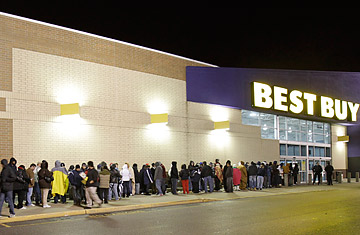
Shoppers wait for doors to open at a Best Buy in Mayfield Heights, Ohio, on Nov. 26, 2010
Bargain-hunting Americans opened their wallets a little wider this year as they flocked to stores and retail websites this Thanksgiving holiday weekend. Yet some analysts say the increase from last year's depressed shopping was smaller than expected and many remain cautious heading into the rest of the holiday retail season.
Preliminary figures indicate 212 million people shopped in stores or online between Thursday and Sunday, up 8.7% from 195 million during the same period a year ago, according to the National Retail Federation (NRF). And they spent more: the average shopper forked over $365.34, which is 6.4% more than a year earlier, but still down from the 2008 peak year of $372.57. Even more impressive, NRF estimates total spending for the Black Friday period (which includes Thursday, Friday, Saturday and estimates for Sunday) hit $45 billion — its highest level ever for the holiday shopping season's kickoff weekend.
However, as NRF points out, Black Friday–weekend sales are not necessarily indicative of how overall holiday shopping will play out. "It was the consumers' search for deals and bargains that drove the weekend traffic rather than their confidence in the economy," says Phil Rist, executive vice president of BIGresearch, which conducted the survey for the NRF.
Indeed, ShopperTrak, which tracks traffic and sales at more than 30,000 retail locations (but not online stores), reported a 2.2% traffic increase and only a 0.3% rise in sales on Black Friday itself from a year ago. The firm's founder, Bill Martin, says the modest sales gain was below expectations and likely reflects consumer insistence on bargains before actually spending. "We had anticipated the holiday season would see a 3.2% rise and you would think that some of that would translate to Black Friday, and so it's below our expectations," says Martin.
Still, it may be, as Martin speculates, that early-November sales and door-buster events cut into Black Friday sales. He notes that sales and traffic in the first two weeks of November rose 6.1% and 6.2% respectively over year-ago levels. "Retailers were very conscious of driving traffic early in November and in doing so, some might have thinned Black Friday spending a bit," he says.
Martin is maintaining his 3.2% sales increase projection for the 2010 holiday season, while the NRF reiterated its 2.3% projection.
By contrast, online shopping did not disappoint this weekend, as cybersales on Thanksgiving Day, Black Friday and Saturday surged 14% from the same period a year ago, according to John Squire, chief strategy officer at IBM Coremetrics, which tracks online marketing and sales. Ellen Davis, a vice president at NRF, estimates one-third of all Black Friday–weekend retail dollars were spent online.
Sales on Thanksgiving Thursday were particularly strong, soaring more than 30%, while Black Friday online sales climbed 15.9%, says Squire. Jewelry sales saw the biggest year-over-year gains, rising 17.6%, says Squire. In fact, the number of people buying jewelry jumped to 14.3% of all shoppers from 11.7% a year ago, indicating "consumer appetite for more of those fun discretionary gifts is back," says the NRF's Davis.
Experts say they wouldn't be surprised if retailers slap even heftier discounts on items in the weeks leading up to Christmas. Since Christmas falls on a Saturday, retailers will have one fewer weekend to sell merchandise, says Laura Gurski, partner and head of A.T. Kearney's retail practice. Also, many are feeling pressured by shoppers who are using phone apps to compare prices while they're in the store aisles.
It took promotions of 40% to 50% off to get customers into the stores over the Black Friday weekend, says Keith Jelinek, director in the Global Retail Practice at AlixPartners, a business-advisory firm. "I suspect we will see a continuation [of this] between now and Christmas Eve," he says.
